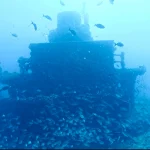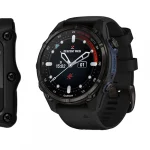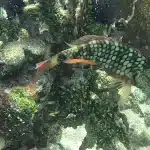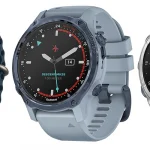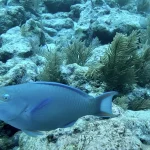Table of Contents
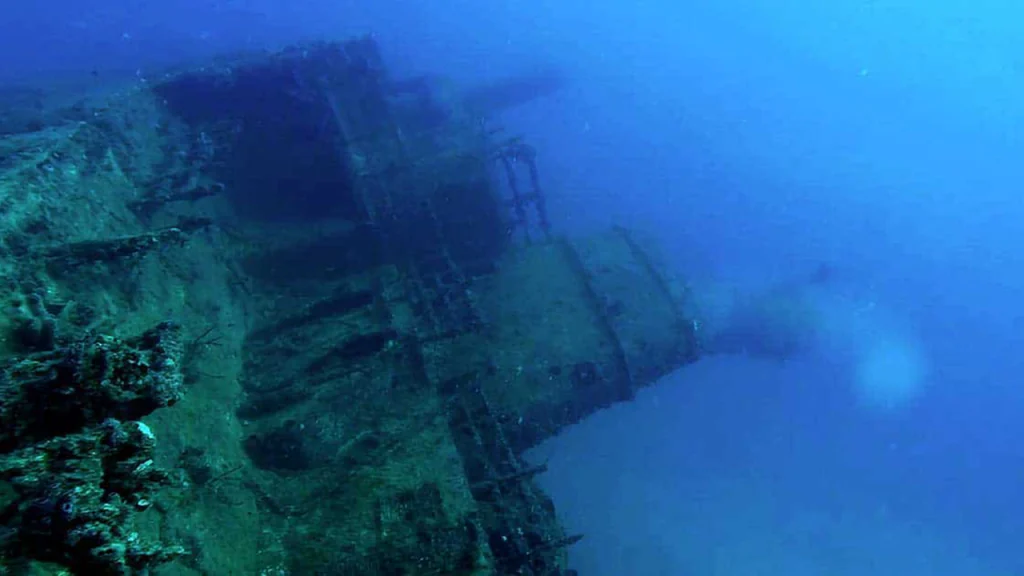
The Eagle’s transformation from a commercial freighter to an artificial reef exemplifies the practice of repurposing decommissioned vessels for marine conservation and recreational diving purposes.
Article at a Glance
- Location and Coordinates: The Eagle shipwreck is located off Lower Matecumbe Key in the Florida Keys at coordinates 24° 52.180′ N, 80° 34.210′ W, resting at depths ranging from 70 to 110 feet.
- Historical Background: Launched in 1962 as the Raila Dan, the ship served as a freighter before being declared a total loss after a fire in 1985. It was intentionally sunk as an artificial reef later that year.
- Unique Features: The wreck is notable for its dramatic structure, having been broken in half by Hurricane Georges in 1998. This allows divers to explore its interior while still observing significant structural elements like the pilot house and cargo booms.
- Marine Life: The Eagle is home to a rich diversity of marine life, including schools of grunts, goliath groupers, bull sharks, and various coral species, making it a vibrant underwater ecosystem.
- Diving Experience: Often referred to as the “crown jewel” of wreck diving in the Florida Keys, the Eagle offers a range of depths and is popular for both recreational and educational dives.
- Safety Measures: Divers are required to have advanced certification, and safety measures include mooring buoys, dive briefings, guided dives, and the use of surface marker buoys for safety stops.
- Dive Shops: Several dive shops in Islamorada, such as Key Dives, Islamorada Dive Center, and Florida Keys Dive Center, offer trips to the Eagle shipwreck, providing experienced guides and equipment for a safe diving experience.
Shipwreck Location Coordinates and Depth
Depth
The Eagle rests at the following depths:
- Maximum depth: 110-120 feet
- Top of the superstructure: Around 70 feet
- Deck railings: Visible at about 70 feet
- Propeller and rudder: Visible at 110 feet
Location Coordinates
The Eagle shipwreck is located:
- 6 miles off Lower Matecumbe Key in the Florida Keys
- About 3 miles northeast of the light at Alligator Reef
The precise GPS coordinates are:24° 52.180′ N, 80° 34.210′ W
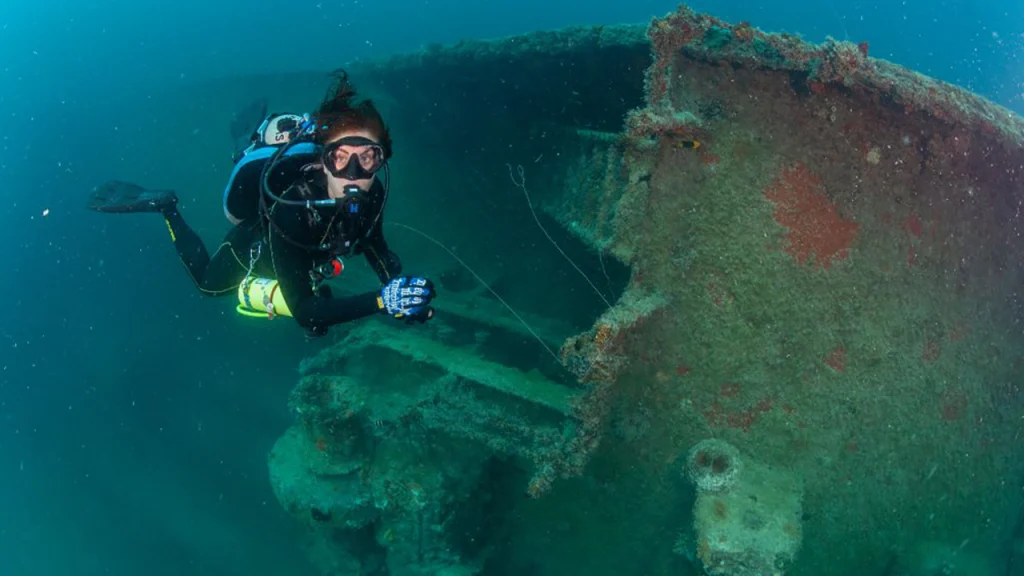
What Do Scuba Divers Say About This Ship
Unique Dive Experience
- Visual Impact: Upon descending, divers are often struck by the scale and structure of the Eagle, which lies on its starboard side at approximately 115 feet. The ship’s broken condition, a result of Hurricane Georges in 1998, allows for an exciting exploration of its interior without needing to penetrate deep into the wreck1.
- Marine Life: The wreck is home to a vibrant array of marine life. Divers frequently encounter schools of sardines, cigar minnows, and grunts, along with larger species like goliath groupers and bull sharks. The diverse ecosystem thriving around the wreck adds to the allure of the dive1.
Accessibility and Conditions
- Diving Conditions: The Eagle is often described as an excellent site for advanced divers, with visibility typically ranging from 50 to 100 feet. However, divers should be prepared for variable currents, which can range from moderate to strong.
- Entry Points: The wreck was designed with entry points for divers, including cutouts and holes blasted into the hull, although these became less relevant after the ship settled on its side. This design makes it easier for divers to explore the wreck without feeling claustrophobic.
Popularity Among Divers
- Crown Jewel of Wreck Dives: Many divers consider the Eagle to be the “crown jewel” of wreck diving in the Florida Keys, often recommending it as a must-visit site for anyone diving in the area. It is frequently included in dive charters due to its popularity and the exciting dive opportunities it presents.
- Educational Value: The wreck is also used for teaching penetration diving techniques, as it offers safe entry points and a chance to observe marine life up close, making it a valuable site for both recreational and educational dives.
What Kind of Marine Life Can Be Found on The Ship
Fish Species
- Large schools of smaller fish, including:
- Sardines
- Cigar minnows
- Grunts
- Blue runners
- Yellowtails
- Larger pelagic fish such as:
- Jacks
- Amberjack
- Pompano
- Occasionally sailfish or marlin (though rare)
- Reef fish that have made the wreck their home
Large Marine Life
- Goliath groupers
- Bull sharks (commonly seen circling the perimeter)
- Sea turtles
- Eagle rays
Invertebrates and Coral Growth
- The wreck is heavily encrusted with coral and sponges, providing habitat for many species
- Octopuses
- Moray eels
- Coral banded cleaner shrimp
Colonization Process
The search results describe how marine life colonized the wreck over time:
- Small hydroids and barnacles were the first to inhabit the wreck
- Keelworms followed closely behind
- These early colonizers paved the way for other animals and seaweeds to grow on their hard shells
- Filter feeders thrived in areas with enhanced currents, such as the superstructure
Key Information
| Category | Information |
|---|---|
| Geographic Location | Situated off Lower Matecumbe Key in the Florida Keys |
| GPS Coordinates | 24° 52.180′ N, 80° 34.210′ W |
| Depth Range | Approximately 70 feet at the top to 110 feet at the bottom |
| Ship History | Originally launched as Raila Dan in 1962; sank in 1985 after a fire incident |
| Structural Characteristics | Notable for being split in half by Hurricane Georges; features a pilot house and cargo booms |
| Biodiversity | Supports a variety of marine life, including schools of fish, goliath groupers, and bull sharks |
| Diving Reputation | Regarded as a premier dive site; ideal for both recreational diving and training |
| Safety Protocols | Requires advanced diving certification; includes measures like mooring buoys and guided dives |
| Local Dive Operators | Key Dives, Islamorada Dive Center, Florida Keys Dive Center offer trips to the wreck |
What Makes The Eagle Shipwreck a Unique Diving Experience
Dramatic Structure and Layout
- The ship lies on its starboard side at about 115 feet depth, creating an impressive visual upon descent1.
- Hurricane Georges in 1998 broke the ship in half, allowing divers to see deep inside the hull without full penetration1.
- The fractured structure gives the appearance of a torpedoed ship, adding to its allure.
Rich Marine Ecosystem
- The wreck is heavily encrusted with colorful coral and sponges, creating a vibrant underwater landscape1.
- It serves as a sanctuary for diverse marine life, including:
Accessible Exploration
- The pilot house offers a unique, non-claustrophobic penetration experience with windows all around.
- Hurricane damage has opened up the wreck, allowing divers to explore interior spaces without advanced penetration techniques.
Historical Significance
- Originally built in 1962 and intentionally sunk in 1985, the Eagle has a rich history1.
- It’s part of the Florida Keys Wreck Trek, a series of intentionally sunk ships forming artificial reefs.
Diving Conditions
- The wreck starts at around 75 feet and descends to 110 feet, offering a range of depths for divers.
- It’s considered a flagship wreck in the Islamorada area, often referred to as the “crown jewel” of local dive sites.
How Does The Eagle Compare to Other Shipwrecks in Florida
Size and Structure
- At 287 feet long, the Eagle is one of the larger wrecks in the Florida Keys.
- It’s part of the Florida Keys Wreck Trek, a series of nine intentionally sunk ships forming artificial reefs.
Unique Configuration
- Unlike many intact wrecks, the Eagle was broken in half by Hurricane Georges in 1998 and now lies on its starboard side.
- This configuration gives divers the impression of a “torpedoed” ship, making it visually striking and unique.
Accessibility
- The wreck’s broken state allows divers to see deep inside the hull without requiring advanced penetration techniques.
- The pilot house offers a non-claustrophobic penetration experience with windows all around.
Marine Life
- Due to its long time underwater (sunk in 1985), the Eagle is “absolutely loaded with life”.
- It’s known for attracting large marine life like sea turtles, eagle rays, and bull sharks.
- The wreck is considered one of the best places in the Keys to spot bull sharks.
Diving Experience
- The Eagle is often referred to as the “crown jewel” of Islamorada diving.
- It offers a range of depths from about 70 feet at the deck railings to 110 feet at the propeller and rudder.
- The wreck is commonly used for teaching penetration dives due to its easily accessible structure.
Historical Significance
- The Eagle has a rich history, having changed names and ownership multiple times before being intentionally sunk.
- It’s part of one of the most successful artificial reef projects in the country.
What is The Full History of This Ship
Origins and Early Years
- Launched in December 1962 at Werf-Gorinchem, Holland
- Originally named Raila Dan
- Built as a conventional hull freighter
Operational History
- Over the next 20 years, the ship had several owners
- Underwent seven name changes after its launch
- Served as a cargo freighter during this period
Final Commercial Voyage
- On October 6, 1985, while named Arron K., the ship caught fire 100 miles south of Miami
- Two U.S. Coast Guard cutters responded to its distress call
- The ship’s superstructure was destroyed in the fire
- Declared a total loss after this incident
Transition to Artificial Reef
- Purchased by the Florida Keys Artificial Reef Association for $30,000
- Joe Teitelbaum, a private citizen, donated an additional $20,000 for the artificial reef project
- Renamed Eagle Tire Company in recognition of a sponsoring business
- Cleaned, gutted of all wooden parts, and stripped of oil and fuel to protect marine life
Sinking
- Originally planned to be sunk next to the Alexander Barge artificial reef
- On December 19, 1985, it broke free from its moorings at the designated sinking spot
- The crew dropped its port anchor to stop it from drifting further
- Sunk on December 20, 1985, slightly north of the intended location
Post-Sinking History
- Became a popular dive site in the Florida Keys
- In 1998, Hurricane Georges broke the ship in half and laid it on its starboard side
- Further damaged by Hurricane Irma in 2017, particularly in the bow area
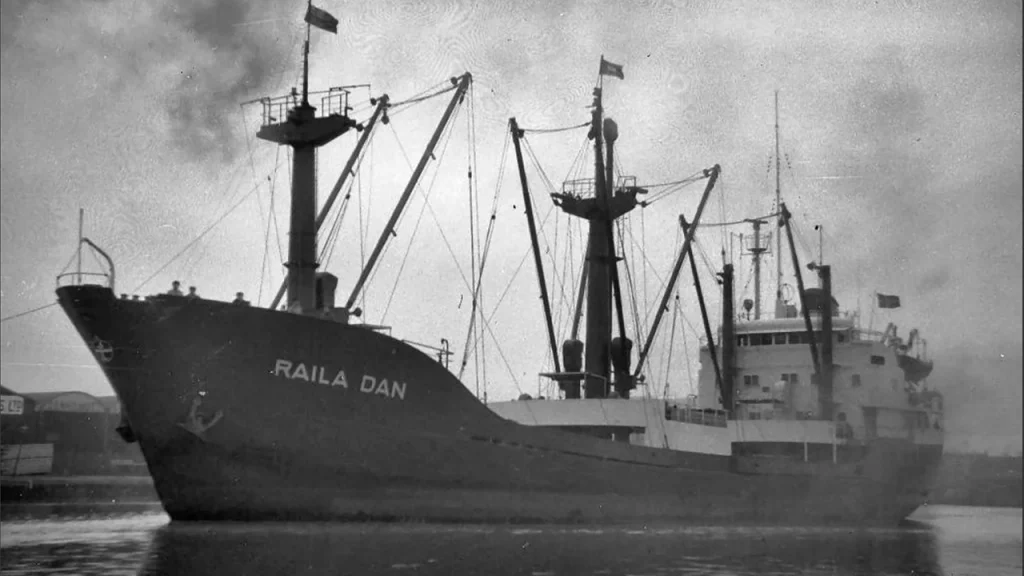
What Historical Features Can Still Be Identified on The Eagle Wreck
Structural Elements
- Large anchor chain: Exits the hawse pipe on the port bow and extends a considerable distance before disappearing into the sand.
- Mast assemblies: Two large mast assemblies rest on the bottom – one on the forecastle and another amidships between cargo bays. Each has its own ladder and observation platform still in place.
- Cargo booms: A tandem set of cargo booms is visible toward the stern.
- Deck railings: Still intact at around 70 feet depth.
- Propeller and rudder: Visible and intact at 110 feet depth.
Navigational Features
- Pilot house: Offers a unique, non-claustrophobic penetration experience with windows all around.
Evidence of Its History
- Fire damage: Heat damage from the 1985 fire that led to the ship being declared a total loss can still be observed in the stern quarter.
- Hurricane damage: The ship is broken in half due to Hurricane Georges in 1998, allowing divers to see deep inside the hull.
Marine Growth
- While not a historical feature of the ship itself, the heavy encrustation of coral and sponges on the wreck is evidence of its 35+ years underwater since being intentionally sunk in 1985.
What Safety Measures Are in Place for Divers Visiting the Eagle
- Advanced certification requirement: The Eagle is considered an advanced dive site due to its depth and potential for strong currents. Divers are typically required to have advanced open water certification or equivalent experience.
- Mooring buoys: Three mooring buoys are attached to the wreck – one at the bow, one midship, and one at the stern. These allow dive boats to securely tie up without damaging the wreck and provide fixed descent/ascent points for divers.
- Dive briefings: Dive operators typically provide thorough briefings on the site conditions, potential hazards, and dive plan before entering the water.
- Guided dives: Many operators offer guided dives with experienced dive masters familiar with the site.
- Current considerations: Divers are advised to use the mooring lines for descent and ascent due to variable currents that can range from moderate to strong.
- Limited penetration: While the wreck’s broken state allows for some exploration of interior spaces, full penetration is generally not recommended without proper training and equipment.
- Depth monitoring: With the wreck sitting at depths from about 70 to 110 feet, divers must carefully monitor their depth and bottom time.
- Safety stops: Due to the depth, safety stops are required at the end of dives.
- Surface marker buoys: Use of surface marker buoys (SMBs) is often recommended for the safety stop and ascent, especially given the site’s location 6 miles offshore.
- Emergency resources: The nearby Coast Guard Station Islamorada provides rapid response capabilities in case of emergencies, as demonstrated by the rescue of an unresponsive diver mentioned in one of the search results.
Dive Shops That Provide Diving Trips to This Shipwreck
- Key Dives
- Address: 85960 Overseas Hwy #2, Islamorada, FL 33036
- Phone: (305) 664-2211
- Website: https://keydives.com/
- Islamorada Dive Center
- Address: 84001 Overseas Hwy, Islamorada, FL 33036
- Phone: (305) 664-3483
- Website: http://islamoradadivecenter.com/
- Florida Keys Dive Center
- Address: 84001 Overseas Hwy, Islamorada, FL 33036
- Phone: (305) 852-4599
- Website: https://www.floridakeysdivecenter.com/

